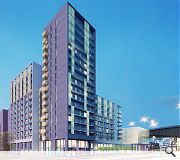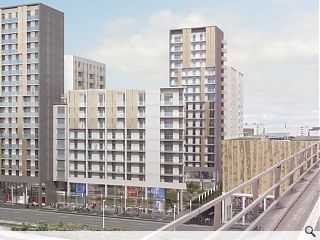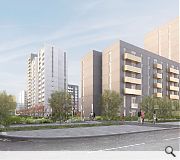Dandara resuscitate huge Clydeside flats plan
May 29 2015
Dandara have resuscitated plans for a huge mixed use scheme at Glasgow’s Cheapside Street; incorporating 603 flats, 1,616sq/m of commercial space and associated public realm.Designed by Axis Mason Architects City Wharf will incorporate a series of resident’s gardens, courtyards and roof terraces overlooking the River Clyde and Kingston Bridge on 1.5ha of brownfield land.
Adopting a stepped profile the scheme will see chequerboard blocks increase in height from the north to an 18 storey riverfront tower and public square. Clad predominantly in pre-cast concrete panels with areas of reconstituted Portland stone the designers have opted for darker, granite coloured, concrete to accentuate corner elements.
Perforated metal panels will be used to clad an on-site car park set within a linear park to the east of the site, intended to act as a buffer to the elevated motorway beyond.
In their design statement the architects noted: “An enhanced concrete finish is proposed at the base two storeys of each building, this will be achieved through creating a distinct pattern or texture in the concrete. This layer of enhancement on the base floors reinforces the datum that is carried through all the buildings. Opportunities also exist to carry the enhanced finish at higher levels of the elevations.
“Recessed areas on the elevations have been expressed through the use of a contrasting precast panel finish and perforated metal panels.”

The linear park will extend to landscaped areas between apartment buildings and to space under the Kingston Bridge
|
15 Comments
#1 Posted by Roddy_ on 29 May 2015 at 13:45 PM
Static , plodding and lumpen. The designers have been paying far too much attention to the worst that Glasgow Harbour has to offer. Not good enough for a site as important as this.
#2 Posted by Shiny Beast on 29 May 2015 at 15:36 PM
"Concrete modernist lefty rubbish"... I hear someone say.
Picture 2 being a particularly splendid example
Picture 2 being a particularly splendid example
#3 Posted by wonky on 29 May 2015 at 16:07 PM
Whereas visual veticality of the western elevation is interesting, the eastern section close to the Kingston Bridge is poor- bolder verticality is needed on that side as a buffer to the motorway; not only for practical reasons but also to alleviate the oppressive presence of the motorway in that area. It was an opportunity to somehow reclaim the space for human-social purposes- instead we get a small glass box for cars? I can't agree that its designers have been 'paying too much attention to the worst that Glasgow Harbour has to offer'- Dandara seemed to have heeded the calls for mixed usage in the scheme- that is a positive. But Roddy is right in that it lacks ambition for such a potentially key nodal site- but that seems to be where we are at present ( not only in Glasgow but in the UK in general): ambition is at a low ebb & that is a consequence of our paucity of expectation, such as..."Well at least its better than a horrible gapsite"- this I guess is something we're all guilty of.
#4 Posted by james on 29 May 2015 at 17:14 PM
I really don't see any substantive difference between Seifert's late 60s DAZ and today's OMO. Compare and contrast. See how far we've come...
https://archaeologicaldrift.files.wordpress.com/2014/03/anderston1.jpg
https://archaeologicaldrift.files.wordpress.com/2014/03/anderston1.jpg
#5 Posted by wonky on 29 May 2015 at 17:49 PM
There may not be significant substantive difference in terms of stylistics- but aesthetics apart- the BREEAM certification system does insure modern buildings are designed with superior energy efficiency than in the 60's. If Dandara use a higher end finish than they did at Glasgow Harbour then they will certainly outlive the cheaply made Anderston project.
#6 Posted by wonky on 29 May 2015 at 17:52 PM
That Glasgow Harbour finish of white-render & ceramic tiling looks badly dated already- lets hope for a vastly improved end-product.
#7 Posted by james on 30 May 2015 at 08:24 AM
I take your point about technology re fabric performance and longevity of materials, (however I think we will still demolish this proposal in 50 years time), but belying the similar homogenous appearance of these images and Seifert's demolished dystopia (after Corb's Vers une Architecture), they raise an obvious question - do society's architects no longer have a single 'structural' idea about high density housing that will garner a sense of community and place, or give expression to any collective will? Is the great social experiment well and truly dead? As Thatcher's children ('there is no such thing as society') living here in this outpost of empire are we all now just individual consumers of smart technology and that's about it? Worker bees in a North British hive (well, it certainly doesn't say Glasgow to me). We are born, we live, we get our smartphones strapped onto us, we pay our mortgages, we die.
I mean, concerning the absence of any positive ideology when looking at these images they are well and truly wholly vacuous. So, if absence of something has meaning, then it begs the serious question what is the meaning of people's lives in this place?
I mean, concerning the absence of any positive ideology when looking at these images they are well and truly wholly vacuous. So, if absence of something has meaning, then it begs the serious question what is the meaning of people's lives in this place?
#8 Posted by wonky on 31 May 2015 at 12:35 PM
Any grand progressive idea for society has been weakened by the rise of a homogenized monoculture that emerged out of corporate globalization; it's a 'collective' vision has also been subverted by the consequences of the individualistic doctrine of Thatcherism-Neo-Liberalism that has fragmented the social contract; lastly the positive vision of society has been undermined intellectually by the post-stucturalism-modernism of Althusser, Derrida, Jean Baudrillard etc that has questioned the hegemony of absolutist knowledge-value systems- hence our present neo-Nietzschean pluralist relativism. Can we have collective will in a plural society?
The international style- arguably an architectural representation of globalized capital- has been with us since Raymond Hood's New York Mcgraw-Hill building or PSFS Building in Philadelphia & of course later with Van der Rohe's Seagram Building in 58' so none of this is nothing new- for me in merely begs the question in a plural relativistic culture that negates hegemony how has the hegemony of global capital endured so long (without going back to old Marxist analysis of infrastructure-superstructure models)? In terms of living with meaning- that is a question that must go deeper than just how we design buildings (design-architectural practice must emerge out of, be inspired by & reflect deeper structures of meaning that contain it)- but how do we recover individual meaning that speaks collectively to us all? Personally the individualistic models that prevail at present will need to be reviewed in terms of their long term human-ecological consequences- but not to be replaced by the old collectivist models but something that includes the needs of the individualist doctrines with the 'higher social needs' of a more advanced culture: how would the built environment reflect that form of culture? The present milieu is merely a historical blip or kink that will pass ( let us just hope the sterilized barbarism of individualistic extremism does not destroy civilization before then)- but it is difficult not to be cynical but in this period of global capitals hegemony we must preserve some immunity to pessimism in order to have the energy to 'resist' it before it finally collapses.
The international style- arguably an architectural representation of globalized capital- has been with us since Raymond Hood's New York Mcgraw-Hill building or PSFS Building in Philadelphia & of course later with Van der Rohe's Seagram Building in 58' so none of this is nothing new- for me in merely begs the question in a plural relativistic culture that negates hegemony how has the hegemony of global capital endured so long (without going back to old Marxist analysis of infrastructure-superstructure models)? In terms of living with meaning- that is a question that must go deeper than just how we design buildings (design-architectural practice must emerge out of, be inspired by & reflect deeper structures of meaning that contain it)- but how do we recover individual meaning that speaks collectively to us all? Personally the individualistic models that prevail at present will need to be reviewed in terms of their long term human-ecological consequences- but not to be replaced by the old collectivist models but something that includes the needs of the individualist doctrines with the 'higher social needs' of a more advanced culture: how would the built environment reflect that form of culture? The present milieu is merely a historical blip or kink that will pass ( let us just hope the sterilized barbarism of individualistic extremism does not destroy civilization before then)- but it is difficult not to be cynical but in this period of global capitals hegemony we must preserve some immunity to pessimism in order to have the energy to 'resist' it before it finally collapses.
#9 Posted by james on 1 Jun 2015 at 01:54 AM
Wonky, I wonder if you'll be shot down here for the mortal sin of using 'big' words. I guess you know, you're not meant to think, or question, just consume.
Anyway, if the architecture of the built environment is a direct expression of our politics, our society, and our values then in this example it is perhaps painfully so. Being a simple man, I have to ask whatever was wrong with the scale and form of the traditional tenement that provided a streetscape, a place, a community, a garden, identity, a neighbourhood of a city? All that boring stuff.
Yes, there is a car showroom and shops. It's what's called 'mixed development' and we're all supposed to go woop-de-dooh! But, whitaboot the gairdens? - So much for agriculture putting the 'culture' into culture then. Nope, society is way too smart for that. What a load of pap we have been fed. Never mind a 'grand progressive idea' - even a wee single one would have done in the instance of this proposal.
Public infrastructure and collective effort should not just be sold off to private capital that can ride on the back of it for short-term gain. It could be said to them, 'Go build your own city, then build whatever blocks you want. Make sure though and have sufficient funds to police the fall-out.' This is truly parasitical architecture. I see no benefit to the host whatsoever.
But I am afraid to say that the collapse of capitalism has been foretold more times than I've had hot dinners - so I'm not holding out much hope there, indeed, I find no personal salvation in 'politics', at all for that matter. Or, to finish, as yon philosopher Neil Young says:
'I could live inside a tepee
I could die
In Penthouse thirty-five...'
Anyway, if the architecture of the built environment is a direct expression of our politics, our society, and our values then in this example it is perhaps painfully so. Being a simple man, I have to ask whatever was wrong with the scale and form of the traditional tenement that provided a streetscape, a place, a community, a garden, identity, a neighbourhood of a city? All that boring stuff.
Yes, there is a car showroom and shops. It's what's called 'mixed development' and we're all supposed to go woop-de-dooh! But, whitaboot the gairdens? - So much for agriculture putting the 'culture' into culture then. Nope, society is way too smart for that. What a load of pap we have been fed. Never mind a 'grand progressive idea' - even a wee single one would have done in the instance of this proposal.
Public infrastructure and collective effort should not just be sold off to private capital that can ride on the back of it for short-term gain. It could be said to them, 'Go build your own city, then build whatever blocks you want. Make sure though and have sufficient funds to police the fall-out.' This is truly parasitical architecture. I see no benefit to the host whatsoever.
But I am afraid to say that the collapse of capitalism has been foretold more times than I've had hot dinners - so I'm not holding out much hope there, indeed, I find no personal salvation in 'politics', at all for that matter. Or, to finish, as yon philosopher Neil Young says:
'I could live inside a tepee
I could die
In Penthouse thirty-five...'
#10 Posted by Neil C on 1 Jun 2015 at 09:22 AM
Big words are fine as long as it all makes sense. Unfortunately both of you often trip over into existential clapatrap , so I guess you must be tutors?
#11 Posted by Neil C on 1 Jun 2015 at 10:16 AM
Unless of course both posts are meant to be a joke, in which case very good.
#12 Posted by james on 1 Jun 2015 at 10:57 AM
#10 My point exactamundo! - Just yous eat yer cereal!
Clapatrap? Am i missing something? Haven't heard that before and there was me thinking I was speaking plainly!
#11 Well, i am serious.
Anyway, as an aside, here's an interesting commentary on the more global view of 'things', or political philosophy if you prefer, of which 'architecture' is undeniably a part.
http://www.truthdig.com/report/item/karl_marx_was_right_20150531
Clapatrap? Am i missing something? Haven't heard that before and there was me thinking I was speaking plainly!
#11 Well, i am serious.
Anyway, as an aside, here's an interesting commentary on the more global view of 'things', or political philosophy if you prefer, of which 'architecture' is undeniably a part.
http://www.truthdig.com/report/item/karl_marx_was_right_20150531
#13 Posted by George on 1 Jun 2015 at 12:28 PM
Meanwhile back in the real world.....
#14 Posted by maybeesaye on 1 Jun 2015 at 13:50 PM
Its far from perfect, but id say its an improvement on the previously approved scheme...
http://www.glasgowarchitecture.co.uk/city-wharf
http://www.glasgowarchitecture.co.uk/city-wharf
#15 Posted by Weegieborn and bred on 5 Jun 2015 at 13:20 PM
not sure what is worse - the architecture proposed or the pretentious epistle from wonky. Look beyond the expressway on the north side at Anderston and you'll find some good examples of design that take account of the local scale and street pattern and provide high quality, attractive homes, (flats are homes as well as back and front garden hooses). there is an almost total lack of imagination in use of materials etc. TWO words - just awful! another TWO words - not Glasgow.
Post your comments
Read next: Dalry student housing scheme set to rise
Back to May 2015
Like us on Facebook
Become a fan and share
News Archive
Search News
Features & Reports
For more information from the industry visit our Features & Reports section.




